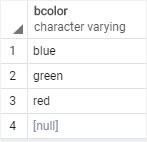
- Postgresql select into temp table drivers#
- Postgresql select into temp table update#
- Postgresql select into temp table code#
A use case for state: Filtering and updating Reducing the number of temporary tables considerably lowers resource consumption, making temporary tables relatively cheap and viable as a strategy for storing state during a transaction. In addition to this, you should be aware of the number of temporary tables being created in a given transaction: I highly recommend re-using existing tables rather than creating dedicated ones for similar use cases, as you will notice PostgreSQL spends a lot of CPU time creating the tables. This will create a new table called state (make sure you don’t have a table with this name already!), which will be deleted at the end of a transaction block.įor performance reasons, the PostgreSQL documentation states that you should run ANALYZE on your temporary table once, in case you’re dealing with complex queries, as the autovacuum daemon cannot access temporary tables. Temporary Tables all the way downĬreating a temporary table within a transaction is as easy as sendingĬREATE TEMPORARY TABLE "state" (. I haven’t used PL/pgSQL a lot, though, so I’ll focus on temporary tables in this guide.
Postgresql select into temp table code#
Side note: You might think whether we could just create temporary PL/pgSQL functions instead, and you could actually run DO to process an anonymous code block. This gives us the best of both worlds: Fewer roundtrips by harnessing the power of SQL, while being able to deploy new services while old ones are still running, without depending on any functions existing in the database in advance. Furthermore, all queries can be drafted by an external service, sent off to the database instance as one batch, processed in PostgreSQL, and returned to the service again. While you might think this sounds crazy, temporary tables can be created within transactions, and are removed at the end of the transaction, leaving no trace behind.
Postgresql select into temp table update#
This yields a different model of building and deploying services around the database, as you’d need to update the functions in place, which might break existing deployments, and cause a lot of headaches along the way.Īnother idea is to use temporary tables for storing state to use later on. While we could go all-in on PL/pgSQL, usually, functions need to be created in the database in advance.


For one, there is PL/pgSQL, a procedural language in your database instance, allowing you to write functions and procedures, which can use control structures, perform complex computations, and work with anything in your database. PostgreSQL has several ways to deal with more stateful computation.

In most cases, I would be careful of making such a decision, but if you want to go all-in on your database capabilities, let’s get right into it! Assessing our options On the flip side, moving all the logic into your database not only makes you depend more on it, but some parts become much harder to test, debug, and reason about if something goes wrong. This approach naturally has benefits and drawbacks: Without network latency, your requests should see a performance gain, the difference does depend strongly on your infrastructure setup. Offloading the program flow into the database makes your database a place where much more computing happens, compared to just processing queries and handing them back. This is where a whole world of PostgreSQL tools opens up if you are ready to change your mental model about how database communication should happen, and about the role the database takes in your stack.
Postgresql select into temp table drivers#
In most cases, those network roundtrips are negligible, but what if you wanted to reduce it down to sending just one request containing all queries, and receive just one response in return? This is where batching comes in: Most PostgreSQL drivers offer some functionality to send all queries off to the server, then read the response for each statement.īut if we were to go down this route, we couldn’t have any operations depending on earlier ones because we send off all queries at once, without an option to change the control flow later on, right? Especially when you have multiple operations that depend on the outcome of earlier queries, you’re dealing with state. Is this the right way to do it? This is the first time I am doing something with a temp table.Querying databases often happens in multiple network roundtrips. INSERT into product_temp_mapping (accountid, productUID, sampleproductId) Hint: If you want to discard the results of a SELECT, use PERFORM instead.ĬREATE TEMP TABLE IF NOT EXISTS product_temp_mappingįOREACH sampleproductId IN ARRAY productIds When I try to get the data back from the table I get an error: ERROR: query has no destination for result data

I am creating a temp table, and am fetching data from multiple tables and inserting data into it.


 0 kommentar(er)
0 kommentar(er)
